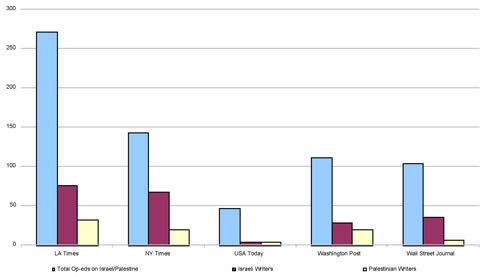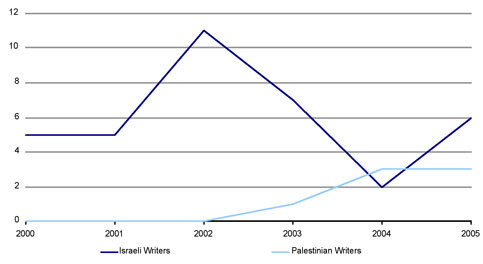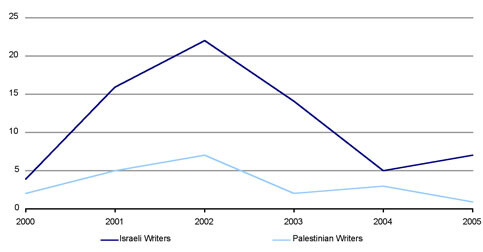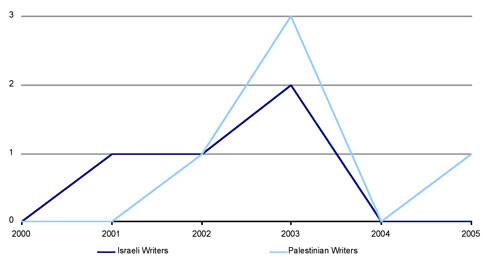Palestine Media Watch 13 March 2006
I. Executive Summary
In the US media, Palestinians generally aren’t allowed to speak for themselves or to articulate their historical narrative. Israelis, however, are permitted to speak, to explain the Israeli experience and even to explain about Palestinians. As a result, the Israeli story is known in the US while Palestinians are dehumanized.
This report exhaustively details the extent to which Palestinian voices have been silenced in the op-ed pages of major US newspapers for the past five years.
This report compares the number of opinion pieces published by Israeli writers with those published by Palestinian writers between September 29, 2000, and December 31, 2005, in the op-ed pages of The Wall Street Journal, The New York Times, The Los Angeles Times, USA Today, and The Washington Post, the five US newspapers with the greatest circulation.
The analysis reveals the following:
II. Findings and Analysis
The research shows that over the last five years and three months, the five US newspapers with the greatest circulation - The Wall Street Journal, USA Today, The New York Times, The Washington Post, and The Los Angeles Times - have published on average 2.5 op-eds by Israeli writers for every op-ed published by a Palestinian writer.
The Wall Street Journal has the least balanced five-year record, averaging 5.1 op-eds by Israelis for every one by a Palestinian, while The New York Times has been the most skewed over the last three years, publishing an average of 4.3 Israeli op-ed writers for every Palestinian.
Through keyword searches using these newspapers’ on-line search engines and on Lexis-Nexis, an exhaustive list was compiled of 680 op-eds on Israel/Palestine published from September 29, 2000 until December 31, 2005. 214 of those op-eds were written by Israelis and 86 written by Palestinians, including Israelis and Palestinians living in Israel/Palestine or abroad.
Figure 1: Op-eds from the Top 5 US Newspapers on Israel/Palestine: Israeli vs. Palestinian Writers during the Second Intifada
Substantial variation among the five newspapers demonstrates that the bias towards Israeli writers is not inevitable. The Wall Street Journal and The New York Times’ five year averages of 5.1 and 3.4 Israelis/Palestinian respectively are followed by The Los Angeles Times with 2.3 Israeli writers per Palestinian writer. In contrast, The Washington Post published 1.4 Israelis for every Palestinian, and USA Today published slightly more Palestinians and Israelis, though USA Today’s total number of Israeli and Palestinian writers (nine) was relatively low. The near parity at The Washington Post and USA Today shows that the over-representation of Israelis in the other newspapers is a product of choices made by editors.
Palestinian citizens of Israel: Another stark finding was the op-ed pages’ complicity in nearly erasing the existence of Palestinian citizens of Israel, 20% of Israel’s population. Though 201 op-eds by Jewish citizens of Israel were published, astonishingly only a single op-ed was published by a Palestinian citizen of Israel currently residing in Israel, Azmi Bishara in The Los Angeles Times.[1]
Palestinian refugees: Palestinian refugees suffer a somewhat similar fate. The United Nations Relief and Works Agency estimates that there are 2.6 million Palestinian refugees living in the Middle East outside of the Occupied Palestinian Territories, many in refugee camps. However, only one op-ed by Palestinian refugee living in the Middle East, Rami Khouri, was published in the five newspapers. [2] Though op-eds by Palestinian refugees living in the United States are sometimes published, the fate of Palestinian refugees and their right of return under international law are almost never addressed on US op-ed pages.
Anti-occupation Israelis: Even Israelis who challenge the narrow mainstream discourse on Israel/Palestine that is accepted in the US are rarely published, despite the general propensity to publish Israelis. In my personal experience in submitting more than 45 op-eds by Israeli and Palestinian writers to these same five US newspapers over the last two and half years, they published only a single op-ed that I was involved with by an Israeli who wrote outside that narrow discourse.
In short, a consistent reliance on establishment voices explains which writers are published and what issues are addressed on Israel/Palestine in the US op-ed pages, not journalistic standards of balance or a concern to represent a variety of views. Establishment Israeli writers echoing the official Israeli narrative dominate the US op-ed pages, privileging a point of view that is already generously represented by syndicated American columnists like Charles Krauthammer, George Will, Jeff Jacoby, Mort Zuckerman, Jonah Goldberg, David Brooks and Max Boot, to name just a few.
By deciding whose voices are heard, the US mainstream media plays a powerful role in shaping the US public’s understanding of Israel/Palestine. Palestinian terrorism is presented continually as the dominant issue in the conflict. In contrast, the US media only occasionally addresses issues like Israeli military occupation, the on-going seizure of Palestinian land and international law. Almost never raised are Israeli discrimination against its Palestinian citizens, Palestinian refugees’ rights of return, Israeli state terrorism, nonviolent Palestinian resistance, and important debates over two states vs. a bi-national state, and over divestment from Israel.
Media bias is not inevitable. It is the result of deliberate editorial choices. If the US media truly aims to present the public with all relevant information and points of view, op-eds and other coverage cannot disproportionately rely on the voices of one side at the expense of the other.
Newspapers like the five examined in this analysis can eliminate the significant imbalance between Israeli and Palestinian voices on their op-ed pages. The bigger challenge is for all levels of the mainstream American media to more equally present both Israeli and Palestinian perspectives so that Americans can make informed decisions on Middle East policy.
III. Detailed Findings for Each Newspaper
A) The Wall Street Journal
The Wall Street Journal published 105 op-eds on Israel/Palestine during the five year and three month period. 36 were written by Israelis and seven by Palestinians, an average of 5.1 Israeli writers for every Palestinian writer. The Journal has the greatest imbalance between Palestinian and Israeli writers over the full period of the intifada. After publishing an astonishing 28 op-eds by Israelis and a single op-ed by a Palestinian by a Palestinian through 2003, the Journal improved in 2004-2005, publishing eight op-eds by Israelis and six by Palestinians, including two by new Palestinian President Mahmoud Abbas.
The Journal’s most frequent op-ed writers on Israel/Palestine are former US negotiator Dennis Ross (seven), Israeli historian Michael Oren (six), right-wing Israeli politicians Benjamin Netanyahu (five) and Ehud Olmert (four), and Palestinian pollster Khalil Shikaki (four). Among those writing three op-eds are right-wing Israeli politicians Natan Sharansky and Dore Gold and right-wing American academics Bernard Lewis, Daniel Pipes and Fouad Ajami.
Not surprisingly, most of the Journal’s writers are from the American and Israeli right. On the rare occasions when Palestinians are allowed to speak, they are “pragmatists” like Mahmoud Abbas and Khalil Shikaki who use language that is very acceptable to Israelis and Americans.
Figure 2: Op-eds from The Wall Street Journal on Israel/Palestine: Israeli vs. Palestinian Writers (2000-2005)
B) The New York Times
The New York Times published 144 op-eds on Israel/Palestine during the period, 68 by Israeli writers and 20 by Palestinian writers, an average of 3.4 Israeli writers for every Palestinian. However, The Times’ record has deteriorated since 2003 when David Shipley became op-ed editor, publishing 25 Israelis, and only six Palestinians, a three year average of 4.3 Israeli writers per Palestinian writer.
The New York Times also has the highest for the percentage of all writers on Israel/Palestine who were Israeli, 47%. The Wall Street Journal was the next highest with 34% Israeli writers.
The Times most frequent op-ed writers are Israeli left-wing politician Yossi Beilin (seven), former US negotiator Dennis Ross (six), former US negotiator Martin Indyk (five), former US negotiator Robert Malley (four), former Israeli politician Ehud Barak (four), Israeli writers David Grossman and Amos Oz (four each), and Israeli professor David Newman (four). The Times also published Israeli politicians Benjamin Netanyahu, Dore Gold, Ephraim Sneh, Shimon Peres and Ariel Sharon.
Thus The Times specializes in propagating the views of failed US negotiators like Ross and Indyk, and center and left of center Israelis (left within an Israeli political spectrum that is quite right). Still, Israelis like Grossman, Oz and Newman have little to no contact with the Palestinians that The Times may perhaps believe they are speaking for.
Palestinian/American negotiator Michael Tarazi (one), US academic Noam Chomsky (one) and US negotiator Robert Malley (four) are the only writers who have been allowed by the Times to stray slightly outside the mainstream discourse accepted in the US, with Tarazi suggesting a single, democratic state as the only remaining, viable solution. Yasser Arafat and Saeb Erekat were also published once each in The Times in 2002.
Figure 3: Op-eds from The New York Times on Israel/Palestine: Israeli vs. Palestinian Writers (2000-2005)
C) The Los Angeles Times
The Los Angeles Times published 272 op-eds on Israel/Palestine, the largest number during the Second Intifada. 77 were written by Israelis and 33 by Palestinians, for an average of 2.3 Israeli writers for each Palestinian writer. The LA Times also publishes a Sunday “Current” section which includes opinion pieces which were classified separately and not included in these summary statistics. Only The LA Times and The Washington Post (“Outlook”) have these extended Sunday sections which are somewhat distinct from the standard daily op-eds carried in all five newspapers.
The LA Times Sunday “Current” published 85 opinion pieces on Israel/Palestine during the 2nd intifada, 37 by Israeli writers and ten by Palestinian writers for an average of 3.7 Israelis per Palestinian, a more imbalanced ratio than The LA Times daily op-ed section. Combining LA Times daily op-eds with “Current” yields an overall average of 2.6 Israeli writers for each Palestinian writer. In the last month LA Times op-ed editor Nick Goldberg was given responsibility for both LA Times Op-eds and the Sunday “Current” section.
Israeli-American writer Yossi Klein Halevi, who writes for The New Republic and is a former member of Meir Kahane’s racist Jewish Defense League, tops The LA Times list of repeat writers with a record 35 op-eds. Lebanese-American activist Hussein Ibish wrote 15. Palestinian-American academic Shibley Telhami was published a total of 10 times in both The LA Times sections, and former US negotiator Dennis Ross nine times. Palestinian journalist Daoud Kuttab wrote seven op-eds, David Grossman wrote seven times total for both sections, and Israeli journalist Yossi Melman wrote seven pieces for the “Current” section.
Klein Halevi’s right-wing views clearly dominated The LA Times op-ed page, though he is now published much less frequently than earlier in the intifada. Otherwise, “centrists” like Dennis Ross, Shibley Telhami, David Grossman and Daoud Kuttab are frequent contributors. In 2004-2005, The LA Times has shown more willingness than the other newspapers to broach less accepted subjects, publishing California-based Palestinian American academics George Bisharat and Saree Makdisi on issues like the right of return for Palestinian refugees and Ariel Sharon’s violent legacy, and Robert Fisk on biased US reporting on Israel/Palestine.
Figure 4: Op-eds from The Los Angeles Times on Israel/Palestine: Israeli vs. Palestinian Writers (2000-2005)
D) The Washington Post
The Washington Post published 112 op-eds on Israel/Palestine during the five plus year period. 29 were written by Israelis and 21 by Palestinians, an average of 1.4 Israelis published per Palestinian. Similar to The LA Times, the The Washington Post publishes a Sunday “Outlook” section which includes longer opinion pieces which were classified separately from op-eds. In “Outlook” the Post published 25 pieces on Israel/Palestine, 10 by Israelis and nine by Palestinians, for an average of 1.1 Israeli writers per Palestinian. Combining the results for the two Washington Post opinion sections yields an overall average of 1.3 Israelis published per Palestinian published.
The Washington Post’s ratio of Israeli to Palestinian writers is close to parity and is the most balanced, with the exception of USA Today which publishes few Israeli or Palestinian writers. On the downside, the range of opinions that Post writers are allowed to express remains narrow.
Located in the US’ political capital, not surprisingly the Post is dominated by politicians, negotiators, diplomatic correspondents and political pundits. Former American negotiators Dennis Ross, Robert Malley and Aaron Miller were published 14, five and three times respectively by The Post. Israeli journalists Gershom Gorenberg and Aluf Benn were published seven and six times respectively. Palestinian American Washington think tank academic Shibley Telhami was published three times, and Palestinian negotiators Michael Tarazi and Saeb Erekat twice each. “Pragmatic” Palestinian pundits Daoud Kuttab and Khalil Shikaki were published five and three times respectively. Israeli Ambassador Danny Ayalon was published twice, and Israeli politicians Dore Gold, David Ivry, Natan Sharansky, Benjamin Netanyahu, Shimon Peres, Silvan Shalom, Ehud Olmert, Yossi Beilin, Ephraim Sneh were each published once. Palestinian politicians Nabil Sha’ath and Marwan Barghouti were also each published once.
Figure 5: Op-eds from The Washington Post on Israel/Palestine: Israeli vs. Palestinian Writers (2000-2005)
E) USA Today
USA Today published the smallest number of op-eds on Israel/Palestine (47), and the fewest Israeli and Palestinian writers (nine). Of 47 op-eds, four were written by Israelis and five by Palestinians, a ratio of 0.8 Israeli writers for every Palestinian writer.
USA Today also publishes what it titles “Opposing Views”. “Opposing Views” are written by outside writers to contrast with a USA Today editorial position. Because “Opposing Views” are unique to USA Today and are specifically intended to serve as a direct counter to a USA Today editorial view, per the suggestion of USA Today editorial staff, they were not tabulated as op-eds. USA Today published 18 “Opposing Views” on Israel/Palestine during the research period, two of which were written by Israelis and two by Palestinians.
Repeat op-ed writers at USA Today on Israel/Palestine include Columbia Journalism professor Samuel Freedman (seven), a member of USA Today’s Board of contributors, American professor Amitai Etzioni (four), also a member of USA Today’s Board on contributors, right-wing Israeli-American journalist Yossi Klein Halevi (three), former US negotiator Dennis Ross (three), and Palestinian-American activist Sherri Muzher (three).
While USA Today is the only newspaper that published slightly more Palestinian than Israeli writers, some of that balance is countered by these other repeat op-ed writers, like the members of USA Today’s Board of Contributors. Samuel Freedman is strongly pro-Israeli, and Amitai Etzioni was an Israeli citizen who fought in the Palmach for Israel’s independence in the 1940s and is quite sympathetic to Israel.
Figure 6: Op-eds from USA Today on Israel/Palestine: Israeli vs. Palestinian Writers (2000-2005)
IV. Research Methodology
For the purposes of this study, op-eds were defined as submissions by outside contributors published in the daily newspaper opinion pages. They do not include articles written by the newspapers’ regular opinion columnists. As noted, variations at The Washington Post (“Outlook”), The LA Times (“Comment”) and USA Today (“Opposing Views”) led to the classification of some articles separately from op-eds to ensure consistent, comparable data between the five newspapers.
The research period of September 29, 2000, the beginning date of the Second Palestinian Uprising or Intifada, until December 31, 2005 was chosen because it was a period of heightened worldwide and US media attention to Israel/Palestine.
The five newspapers with the greatest circulation in the US were chosen to provide a broad overview of what Americans are most likely to read, without a completely exhaustive overview. These newspapers are recognized as “opinion leaders” that both influence and reflect the views of US policymakers, media, and US public opinion.
For this study, Israeli writers included writers publicly described as Israeli citizens, including, dual US and Israeli citizens. Palestinians included Palestinians living in the Occupied Territories, Palestinian citizens of Israel, and Palestinians living outside of Israel/Palestine, who identify themselves as of Palestinian descent. Present or past Palestinian citizens of Israel, Azmi Bishara and Shibley Telhami, were counted twice, once as Palestinian and once as Israeli, though Telhami left Israel to become a US citizen in 1970.
When it was not immediately clear if a writer might be Palestinian or Israeli, thorough Google internet searches were conducted for more background. In two cases writers responded to emails asking for clarification of their status. In the five cases where it was not possible to verify from a credible, written source if the writer was Israeli or Palestinian, the writer was classified as neither.
Op-eds on Israel/Palestine in the five US newspapers were tabulated through keyword searches on Lexis-Nexis, and/or by using the newspapers’ own on-line search engines. The key words used for searches were “Israel” and “Palestinian”. Adding the key words “Israeli” and “Gaza” did not add to the number of op-eds found. While an effort was made to restrict the search to the op-ed/opinion section rather than all articles to save work, some newspaper search engines did not permit this, or doing so was found to leave out many op-eds due to flaws in the search engines.
Op-eds were tabulated as about Israel/Palestine if they were primarily about Israel, about Palestine, or about both. When an op-ed’s focus was unclear from the op-ed summary, the full article was located and read.
While the searches for all op-eds published on Israel/Palestine by the five newspapers were exhaustive, it remains possible that some op-eds were unintentionally omitted. However, the op-eds identified in the study clearly constitute a statistically significant sample. Indeed, in conducting this study, as additional op-eds were located using more refined searches, the overall results for each newspaper and their rankings relative to one another did not change substantially.
The Wall Street Journal: The Wall Street Journal’s on-line search engine did not permit a search restricted only to op-ed articles. Therefore, Lexis-Nexis was used, yielding a list of 1247 articles for the research period. 105 of those were found to be op-eds on Israel/Palestine. The Wall Street Journal did not respond to three email and phone requests that they review or comment on these findings.
The New York Times: It was possible to restrict the search on The New York Times on-line search engine to “Editorials and Op-eds”. 2082 articles were found with the word “Israel”, 1228 articles with “Israeli”, and 3221 articles were found searching for “Palestinian”. From these, 144 op-eds on Israel/Palestine were identified. These results were subsequently confirmed using a Lexis-Nexis search for Israel and Palestinian. The New York Times acknowledged receipt of the detailed data by email, but, despite a number of requests, declined to provide feedback on the data.
The Los Angeles Times: Using The LA Times search engine and limiting searches to “opinion piece” or “opinion” eliminated many op-eds on Israel/Palestine and thus was not reliable. As a result, searches were conducted for all articles using the words “Israel” (8387 articles found), “Israeli” (6578 articles found) and “Palestinian” (5944 articles found). Reviewing those articles resulted in the identification of 357 opinion pieces on Israel/Palestine. 85 of those opinion pieces were published in the Sunday “Current” section, while 272 were published as daily op-eds. The LA Times acknowledged receipt of the data and discussed and reviewed some findings by phone and email.
The Washington Post: It was not possible to restrict the search on The Washington Poston-line search engine to “OP/ED” despite the presence of that filter. A search of all articles for “Israel” or “Israeli” or “Palestinian” yielded 12,551 articles. After review, 137 opinion articles on Israel/Palestine were identified. 25 of those were published in the Sunday “Outlook” section, and 112 were published on the regular, daily op-ed page. These results were confirmed through a subsequent Lexis-Nexis search. The Washington Post acknowledged receipt of the data, noted that it was interesting and valuable, but declined the opportunity provided to review the data in detail or comment.
USA Today: It was not possible to conduct an effective search using USA Today’s on-line search engine because USA Today’s search engine only finds results for the previous six months. A Lexis-Nexis search for the words “Israeli” and “Palestinian” and “opinion” yielded 446 articles. 65 of those articles were opinion articles on Israel/Palestine. Written feedback from USA Today pointed out that a number of those articles, some of which were written by Israelis and Palestinians, were “Opposing Views” articles and should be tabulated as op-eds. On this basis, 18 of the 65 articles were eventually categorized as “Opposing Views.”
Footnotes:
1. US academic Shibley Telhami was born in 1951 as a Palestinian citizen of Israel. He left Israel for the US in 1970. Since then he has lived in the US as a US citizen. Telhami had 12 op-eds published in the five papers, and four articles in the LA Times Sunday �Current�. In compliance with Telhami�s suggestion following an email inquiry, Telhami was classified as Palestinian American, and Israeli.
2. Rami Khouri currently lives in Jordan and Lebanon, but grew up and was educated in the US.
Palestine Media Watch was established in October of 2000 to promote fair and accurate coverage of the Israeli occupation of Palestine in the US mainstream media.





